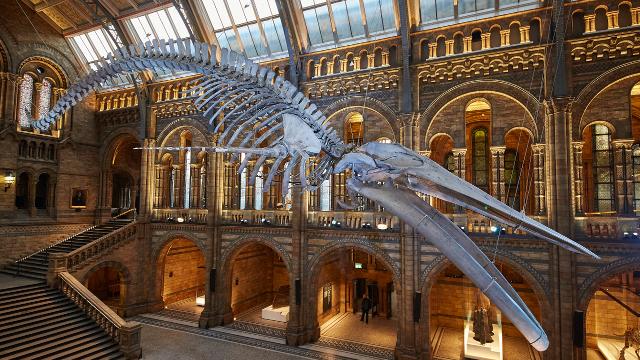The UK is home to some of the most prestigious and fascinating Natural History Museums, offering visitors a deep dive into the world of biodiversity, geology, and palaeontology. From ancient fossils to stunning wildlife displays, these museums provide an educational and entertaining experience for all ages. In this guide, we explore some of the best Natural History Museums in the UK, their key attractions, visitor information, and frequently asked questions.
1. Natural History Museum, London
The Natural History Museum in London is one of the most famous museums in the world. Located in South Kensington, it is home to over 80 million specimens, spanning billions of years of history.
Key Exhibits:
- Hope the Blue Whale – A magnificent skeleton suspended from the ceiling in the Hintze Hall.
- Dinosaur Gallery – Featuring the iconic Tyrannosaurus rex and other prehistoric fossils.
- Earth Hall – A journey through the planet’s geological past, with a giant rotating globe.
- Human Evolution Gallery – Showcasing the evolution of humankind.
- Treasures Gallery – Featuring Charles Darwin’s original specimens and a moon rock.
Visitor Information:
- Location: Cromwell Road, London SW7 5BD, UK
- Opening Hours: Daily from 10:00 AM to 5:50 PM
- Entry Fee: Free (Some temporary exhibitions may require tickets)
- Nearest Tube: South Kensington (Circle, District, and Piccadilly Lines)
2. Oxford University Museum of Natural History
Founded in 1860, the Oxford University Museum of Natural History houses an extensive collection of zoological, palaeontological, and mineralogical specimens.
Key Exhibits:
- Dodo Skeleton – One of the few remaining dodo remains in the world.
- Tyrannosaurus and Iguanodon Fossils – A must-see for dinosaur enthusiasts.
- Mineral and Gemstone Collections – Featuring some of the most dazzling crystals.
- Insect and Butterfly Collections – Showcasing thousands of rare specimens.
Visitor Information:
- Location: Parks Road, Oxford OX1 3PW, UK
- Opening Hours: 10:00 AM – 5:00 PM (Daily)
- Entry Fee: Free
- Accessibility: Wheelchair accessible with lifts and ramps.
3. National Museum of Scotland (Natural Sciences Section)
Located in Edinburgh, the National Museum of Scotland features a spectacular Natural Sciences section, exploring the wonders of life and the Earth.
Key Exhibits:
- Tyrannosaurus rex Skull – A well-preserved and striking fossil.
- Extinct and Endangered Species – Exploring biodiversity conservation.
- Meteorites and Space Rocks – Including specimens from Mars and the Moon.
- Scotland’s Natural History – Showcasing native wildlife and ecosystems.
Visitor Information:
- Location: Chambers Street, Edinburgh EH1 1JF, UK
- Opening Hours: 10:00 AM – 5:00 PM (Daily)
- Entry Fee: Free
- Transport: Well connected via public transport and walking distance from key attractions.
4. World Museum, Liverpool
The World Museum in Liverpool has an extensive natural history section, featuring prehistoric life, ancient marine creatures, and cultural artefacts.
Key Exhibits:
- Ancient Fossils and Dinosaurs – Displaying marine reptile fossils and dinosaur skeletons.
- Aquarium and Insectarium – Featuring exotic fish, spiders, and insects.
- Space and Astronomy Section – Learn about meteorites and the universe.
- Ancient Egypt Exhibition – Showcasing mummies and Egyptian artefacts.
Visitor Information:
- Location: William Brown Street, Liverpool L3 8EN, UK
- Opening Hours: 10:00 AM – 5:00 PM (Daily)
- Entry Fee: Free
- Public Transport: Easily accessible via train and bus routes.
5. Manchester Museum
Part of the University of Manchester, the Manchester Museum houses an impressive natural history collection.
Key Exhibits:
- Stan the T-Rex – A life-size Tyrannosaurus rex skeleton.
- Ancient Egyptian Artefacts – A fascinating look at mummies and hieroglyphics.
- Rare Minerals and Fossils – From ammonites to meteorites.
- Living Worlds Exhibit – Focusing on biodiversity and environmental conservation.
Visitor Information:
- Location: Oxford Road, Manchester M13 9PL, UK
- Opening Hours: 10:00 AM – 5:00 PM (Daily)
- Entry Fee: Free
- Accessibility: Fully accessible with lifts and ramps.
FAQs About Natural History Museums in the UK
1. Are Natural History Museums in the UK free to visit?
Yes! Most Natural History Museums in the UK offer free entry, but some special exhibitions may require a paid ticket.
2. Which is the largest Natural History Museum in the UK?
The Natural History Museum in London is the largest, housing over 80 million specimens and world-famous exhibits.
3. Are the museums suitable for children?
Absolutely! Many museums have interactive exhibits, dinosaur skeletons, and hands-on activities designed to engage young visitors.
4. Do I need to book tickets in advance?
For general entry, booking is not usually required. However, some temporary exhibitions and events may require advance booking.
5. Can I take photos inside the museums?
Yes, photography is allowed in most museums for personal use, but flash photography may be restricted in certain areas.
6. What are the best ways to get to these museums?
Public transport is the best option, as these museums are centrally located and well connected by bus, train, and underground services.
7. Are there guided tours available?
Yes, many museums offer guided tours and audio guides to enhance the visitor experience.
Conclusion
The UK’s Natural History Museums provide a remarkable journey through time, from ancient fossils to modern biodiversity conservation. Whether you’re fascinated by dinosaurs, rare gemstones, or the mysteries of space, these museums have something for everyone. With free entry, engaging exhibits, and a wealth of knowledge, they are a must-visit for families, students, and science enthusiasts alike. Plan your visit today and explore the wonders of the natural world!
